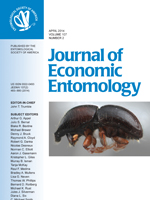The pupal development of Aethina tumida Murray (Coleoptera: Nitidulidae) was studied at various combinations of thermo-hygrometric soil conditions (temperatures of 16, 18, and 20°C and soil water content levels of 0.37, 0.56, and 0.73 m3 water per cubic meter of dry soil) representative of southeastern Canada. Survivorship and development duration of A. tumida pupae, as well as sex ratio and life span of emerging adults, were assessed. Assays were conducted in growth chambers on an average of 50 third-instar larvae per thermo-hygrometric combination. Results show that survivorship of pupae decreased with lower temperature and higher soil water content. Pupal development time shortened as temperature increased (69–78 d at 16°C, 47–54 d at 18°C, and 36–39 d at 20°C), but was longer in dryer soil. Optimal soil water content for pupal development was 0.56 m3 water per cubic meter of soil. We estimated that the minimum development temperature for pupae is between 10.2 and 13.2°C, depending on soil water content. The sex ratio of emerging adults was influenced by soil water content. We measured one female to one male for dry and intermediately wet soils and three females to one male for wet soils. Higher soil water content reduced the life span of emerging adults by half. This study contributes to a better understanding of A. tumida population dynamics in eastern Canada.
How to translate text using browser tools
1 April 2014
Pupal Development of Aethina tumida (Coleoptera: Nitidulidae) in Thermo-Hygrometric Soil Conditions Encountered in Temperate Climates
M. Bernier,
V. Fournier,
P. Giovenazzo
ACCESS THE FULL ARTICLE
It is not available for individual sale.
This article is only available to subscribers.
It is not available for individual sale.
It is not available for individual sale.

Journal of Economic Entomology
Vol. 107 • No. 2
April 2014
Vol. 107 • No. 2
April 2014
Aethina tumida
pupal development
soil water content
temperature




